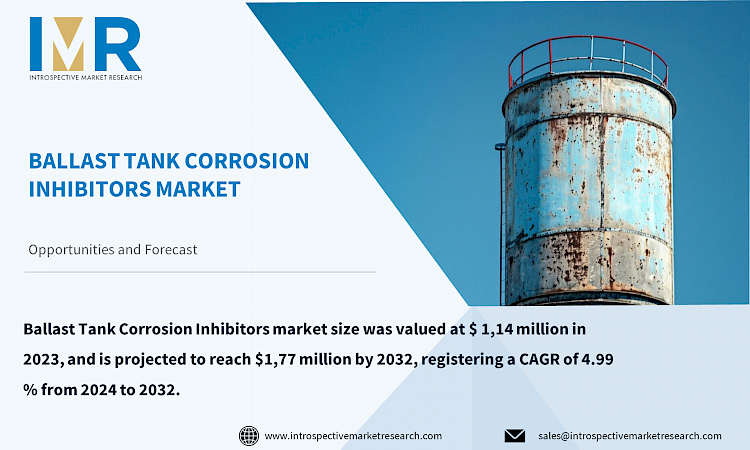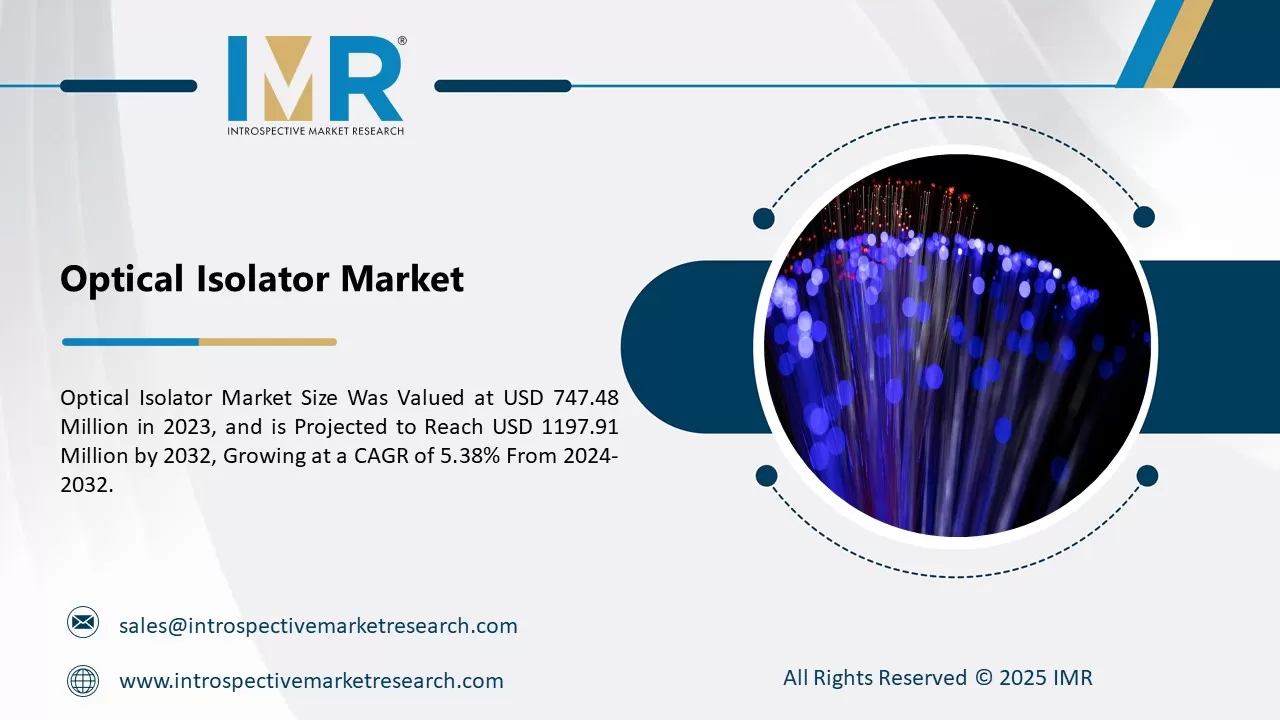Ballast Tank Corrosion Inhibitors Market
According to a new report published by Introspective Market Research, titled, ?Ballast Tank Corrosion Inhibitors Market by Type, Technology, End-User, Distribution Channel and Regions: Global Opportunity Analysis and Industry Forecast, 2024?2032,?
the global Ballast Tank Corrosion Inhibitors market size was valued at $ 1,14 million in 2023, and is projected to reach $1,77 million by 2032, registering a CAGR of 4.99 % from 2024 to 2032.
Ballast water corrosion inhibitors are chemicals used to reduce and prevent corrosion in ship ballast tanks. These tanks, which are essential for maintaining the stability of the ship, are susceptible to rust and damage due to exposure to seawater. Corrosion inhibitors create a protective barrier on the tank surface, reducing the effects of corrosive elements. Ballast water corrosion inhibitors are essential to prolong the life of a ship by preventing corrosion in ballast tanks, which are susceptible to damage from corrosive seawater. This helps to prolong the life of the ship, ensure safer maritime operations, reduce maintenance costs, and improve operational efficiency by minimizing downtime and frequent repairs.
The Ballast Tank Corrosion Inhibitors Market is segmented into Type, Technology, End-User, Distribution Channel, and region. By Type, the market is categorized into Organic Corrosion Inhibitors, Inorganic Corrosion Inhibitors, and Hybrid Corrosion Inhibitors. By Technology, the market is categorized into Solvent-based Inhibitors, Water-based Inhibitors, and Vapor-phase Inhibitors. By End-User, the market is categorized into the Shipping Industry, the Oil and Gas Industry, and the Chemical Industry. By Distribution Channel, the market is categorized into Direct Sales, Distributors, and Online Retail. By region, it is analysed across North America (U.S.; Canada; Mexico), Eastern Europe (Bulgaria; The Czech Republic; Hungary; Poland; Romania; Rest of Eastern Europe), Western Europe (Germany; UK; France; Netherlands; Italy; Russia; Spain; Rest of Western Europe), Asia-Pacific (China; India; Japan; Southeast Asia, etc.), South America (Brazil; Argentina, etc.), Middle East & Africa (Saudi Arabia; South Africa, etc.).
The ballast corrosion inhibitors market is driven by the increasing focus on maintenance and repair activities in the marine industry. Ballast tanks are essential for the stability of ships and are particularly susceptible to corrosion due to exposure to corrosive seawater. The market is driven by the recognition of the role of corrosion inhibitors in extending the life of ships.
Ballast tanks, essential for the stability of ships, are particularly susceptible to corrosion due to exposure to corrosive seawater. The market is driven by the recognition of the role of corrosion inhibitors in extending the life of ships. Ship operators and owners invest in anti-corrosion measures to minimize the effects of rust and deterioration, ensuring the structural integrity of the ship.
Global Ballast Tank Corrosion Inhibitors Market, Segmentation
The Ballast Tank Corrosion Inhibitors market is segmented based on type, technology, end-user, distribution channel, and region.
Type:
The type segment is further classified into Organic Corrosion Inhibitors, Inorganic Corrosion Inhibitors, and Hybrid Corrosion Inhibitors. Among these, the Organic Corrosion Inhibitors sub-segment accounted for the highest market share in 2023. Organic corrosion inhibitors, derived from natural or synthetic sources, have shown remarkable effectiveness in reducing corrosion in ballasts. Their ability to form a protective layer on metal surfaces, inhibiting oxidation, makes them very effective in preventing corrosion damage. Organic corrosion inhibitors are often preferred because of their compatibility with various materials, ease of application, and eco-friendly properties.
Technology:
The application segment is further classified into Solvent-Based Inhibitors, Water-Based Inhibitors, and Vapour-Phase Inhibitors. Among these, the Solvent-based Inhibitors sub-segment is anticipated to show the fastest growth by 2032. Solvent-based inhibitors provide effective corrosion protection by forming a durable barrier on the metal ballast surface. Known for their excellent adhesion properties, which provide long-term protection against the corrosive effects of seawater, this technology is also versatile, making it suitable for a wide range of vessel types and ballast configurations. Their ease of application and compatibility with existing coating systems contribute to their widespread adoption.
Region:
The Ballast Tank Corrosion Inhibitors market in Asia-Pacific is projected to show the fastest growth by 2032. The increasing industrialization of the maritime sectors, especially shipping, shipbuilding, and offshore structures, has led to a rapid increase in the demand for corrosion protection solutions, especially for ballast tanks, which are highly sensitive to corrosion. The Asia-Pacific region has a significant presence of major maritime nations such as China, South Korea, Japan, and Singapore, which play a significant role in the global shipping and shipbuilding industry. These countries have witnessed significant investments in infrastructure development, fleet modernization, and expansion of offshore operations, thereby driving the demand for advanced corrosion inhibition technologies.
Some of the leading Ballast Tank Corrosion Inhibitors market players are
- Cortec Corporation
- Daubert Chemical Company
- Hydrex Holdings LLC
- Performance Chemicals Limited
- AkzoNobel
- Wilh. Wilhelmsen Holding ASA
- Jotun
- Blaukaiser
- Drew Marine
- Chemtec International, and Other Active Players.
Key Industry Developments
- In December 2022, Cortec Corporation completed its acquisition of Cortec Southeast Asia (CSEA) offices in Singapore, marking a significant development in its expansion strategy. Formerly a joint venture, CSEA is now a wholly owned subsidiary of Cortec Corporation. This move aims to enhance customer service and support in Southeast Asia by establishing a direct link with Cortec headquarters in Saint Paul, Minnesota.
Key Findings of the Study / Key Industry Developments.
- Organic Corrosion Inhibitors led the market in 2023 due to their effectiveness, ease of application, and eco-friendliness.
- Solvent-based Inhibitors are set for the fastest growth due to their durability, adhesion, and versatility.
- The Asia-Pacific region is projected to grow the fastest, driven by industrialization and investments in maritime sectors.





